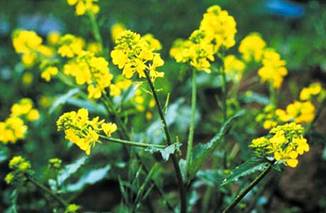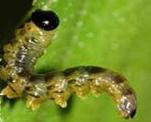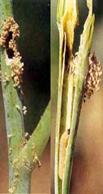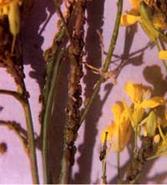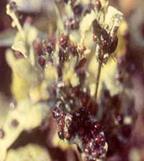TNAU Agritech Portal :: Crop Protection
Important pests of Mustard
Scientific name: Brassica sp Family: Brassicaceae
|
| 1. Diamondback moth: Plutella xylostella |
Symptoms of damage
- Whitish patches due to scrapping of epidermal leaf tissues by young larvae
- The leaves give a withered appearance but in later stages larvae bore holes in the leaves.
- Leaves may be eaten up completely.
- It also bores into pods and feeds developing seed
Identification of the pest
- Larva - Yellowish green, with fine erect black hairs scattered all over the body.
Adult
- Small greyish brown having pale whitish narrow wings with yellow inner margins
- Forewings - have three white triangular spots along the inner-margin.
- Triangular markings of opposite wings appear as diamond shaped
- Hind wings – have a fringe of long fine hairs
Management
- Installing pheromone trap @ 5/ ac. to monitor the moth activity
- Collection and careful destruction of the larvae at gregarious stage at least twice a week.
- Conserve Cotesia plutellae, as it is an important parasitoid for diamond back moth. Diadegma insulare is also the most important parasitoid of the diamondback moth
- For control of grown up larvae apply 5% malathion dust @ 37.5 kg/ha.
|
 |
| Caterpillar feeding |
|
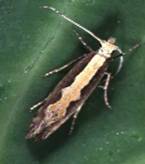 |
Adult |
|
|
| 2. Leaf webber: Crocidolomia binotalis |
Symptoms of damage
- Newly hatched larvae feed initially on the chlorophyll of young leaves and later on older leaves, buds and pods, make webbings and live within.
- Severely attacked plants are defoliated.
- Seeds in the pods are eaten away.
Identification of the pest
- Larva: Pale yellowish-brown, with a series of lateral and sub-lateral black spots and specks
Adult
- Moths are yellowish-brown,
- Forewings - have reddish-brown distinct and in distinct wavy lines and prominent white spots. Nearer to the thorax with black tuft of hair.
- Hind wings: White with dark brown apical area.
Management
|
|
 |
Adult |
|
|
|
| 3.Mustard saw fly: Athalia lugens proxima |
Symptoms of damage
- Initially the larva nibbles leaves, later it feeds from the margins towards the midrib.
- The grubs cause numerous shot holes and even riddled the entire leaves by voracious feeding.
- They devour the epidermis of the shoot, resulting in drying up of seedlings and failure to bear seeds in older plants.
Identification of the pest
- Larva - Greenish black with wrinkled body and has eight pairs of pro-legs. On touch the larva falls to ground and feigns death.
Adult
- Head and thorax is black in colour. Abdomen is orange colour.
- Wings are translucent, smoky with black veins.
|
|
Management
- Summer ploughing to destroy the pupa.
- Early sowing should be done.
- Maintain clean cultivation.
- Apply irrigation in seedling stage is very crucial for sawfly management because most of the larvae die due to drowning effect. Severe cold reduces pest load.
- Collection and destruction of grubs of saw fly in morning and evening
- Conserve Perilissus cingulator (parasitoids of the grubs), and the bacterium Serratia marcescens which infect the larvae of sawfly.
- Use of bitter gourd seed oil emulsion as on anti- feedant.
- Spray the crop with malathion 50 EC @ 1000 ml/ha quinolphos 25 EC @ 625ml/ha. All this should be applied in about
600 to 700 litres of water per ha.
|
|
| 4. Cabbage head borer: Hellula undalis |
Symptoms of damage
- Caterpillars initially mine the leaves and make it white papery.
- Later they feed on leaves and bore into stems.
- Entrance hole is covered with silk and excreta.
Identification of the pest
- Larva - Pale whitish brown with 4 or 5 pinkish-brown longitudinal stripes.
Adult
- Moths are pale greyish-brown, suffused with reddish colour.
- Forewings have grey wavy lines, an apical spot and pale edged dark lunule.
- Hind wings are pale dusky, darker in apical area.
Management
- Collection and careful destruction of the larvae at gregarious stage with leaves twice a week.
- For control of grown up larvae apply 5% malathion dust @ 37.5 kg/ha. or
carbaryl 50 WP@ 375 g in 150 litre of water.
|
|
|
| 5. Leaf miner: Chromatomyia horticola (Phytomyza atricornis) |
Symptoms of damage
- Young maggot mines zig-zag galleries in the leaves
I dentification of the pest
- Larva- small, whitish maggot
- Spray 5 % neem seed kernel extract(NSKE)
|
|
| 6. Mustard aphid: Lipaphis erysimi |
Symptoms of damage
- Both nymphs and adults suck the sap from leaves, buds and pods.
- Curling may occur in infested leaves and at advanced stage plants may wither and die.
- Plants remain stunted and sooty molds grow on the honey dew excreted by the insects.
- The infected filed looks sickly and blighted in appearance.
Identification of the pest
- Aphids - are small, soft-bodied, pearl-shaped insects that have a pair of cornicles (wax-secreting tubes) projecting out from the fifth or sixth abdominal segment.
Favourable seasons
- The aphid attacks generally during 2nd and 3rd week of December and continues till March.
- The most favourable temperature is between 8 and 24o C
- 70 to 80 % humidity is favourable for faster multiplication of aphid.
- Rainy and humid weather help in accelerating the growth of insects.
|
|
Management
- Use tolerant varieties like JM-1 and RK-9501.
- The crop sown before 20th October escape the damage.
- Set up yellow stick trap to monitor aphid population.
- Destroy the affected parts along with aphid population in the initial stage.
- Conserve the following natural enemies: Ladybird beetles viz., Coccinella septempunctata, Menochilus sexmaculata, Hippodamia variegata and Cheilomones vicina are most effcient pradators of the mustard aphid. Adult beetles may feed on an average of 10 to 15 adults/day.
- Several species of syrphid fly i.e., Sphaerophoria spp., Eristallis spp., Metasyrphis spp., Xanthogramma spp andSyrphus spp. are predating on aphids.
- The braconid parasitoid, Diaretiella rapae a very active bio control agent cause the mummification of aphids.
- The lacewing, Chrysoperla carnea predates on the mustard aphid colony.
- Predatory bird Motacilla cospica is actively feeding over aphids in February-March.
- A number of entomogenous fungi, Cephalosporium spp., Entomophthora and Verticillium lecanii infect aphids.
- Spray the crop with one of the following in the flowering stage; oxydemeton methyl, dimethoate@ 625 - 1000 ml per ha.
|
|
| 7. Painted bug: Bargrada hilaris cruciferarum |
Symptoms of damage
- Young plants wilt and wither as a result of the attack.
- Adult bugs excrete resinous substances which spoils the pods.
Identification of the pest
Adult: Bug is black in colour with red and yellow lines
|
|
- Deep ploughing so that the eggs of painted bugs are destroyed.
- Early sowing is needed to avoid pest attack.
- Irrigate the crop during four week after sowing to reduce pest attack
- Quick threshing of the harvested crop should be done.
- Burn the remains of mustard crop so that the stages of insect do not reach the next year crop.
- The bugs usually congregate on the leaves and stem which can be jerked to dislodge them and killed in kerosinised water.
- Conserve bio-control agents like Alophara spp.
- Spray the crop with malathion 50 EC @1000 ml or dimethoate 30EC @ 625 ml in 600- 700 liter water
|
| Updated on June, 2014 |
|
|

